#laser interferometer
Explore tagged Tumblr posts
Text
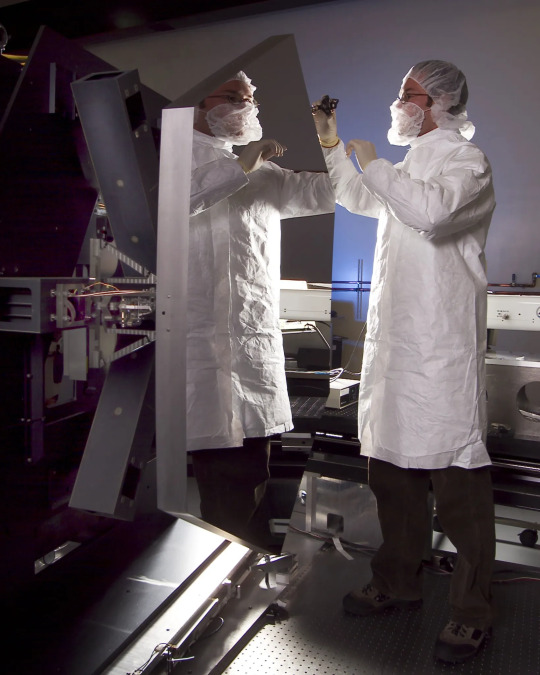
Since many materials change shape when they change temperature, a test team from Ball Aerospace worked together with NASA engineers at Marshall’s X-ray and Cryogenic Facility (XRCF) to cool the mirror segments down to the temperature Webb is experiencing in deep space, -400 degrees Fahrenheit (-240 degrees Celsius).
Cryogenic testing of the primary mirror segments began in at Marshall’s XRCF by Ball Aerospace in 2009.
The change in mirror segment shape due to the exposure to these cryogenic temperatures was recorded by Ball Aerospace Engineers using a laser interferometer. This information, together with the mirrors, traveled back to California for final surface polishing at Tinsley. The mirrors’ final polish was completed in June of 2011.
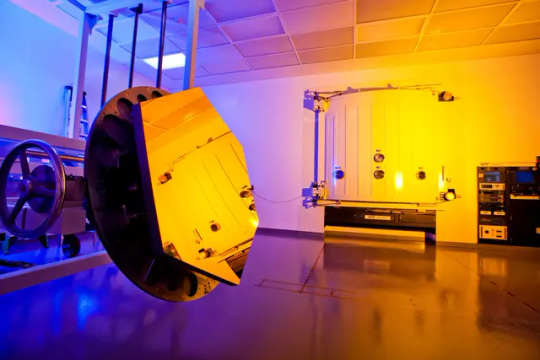
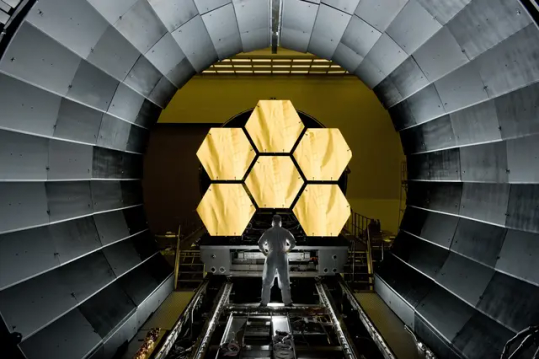
By the end of 2013, all the flight primary mirror segments, as well as the secondary and tertiary mirrors would be at Goddard. The mirrors were stored in special protective canisters in the cleanroom, awaiting the arrival of the flight telescope structure.
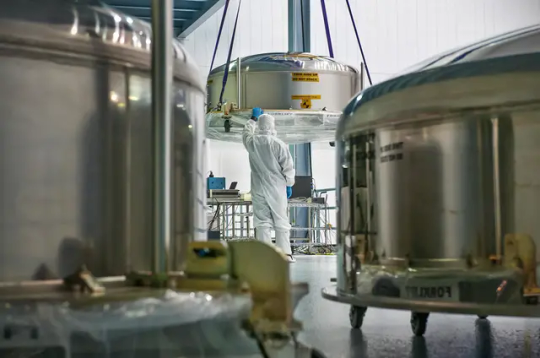
Inside a massive clean room at NASA’s Goddard Space Flight Center in Greenbelt, Maryland the James Webb Space Telescope team used a robotic arm to install the last of the telescope’s 18 mirrors onto the telescope structure.
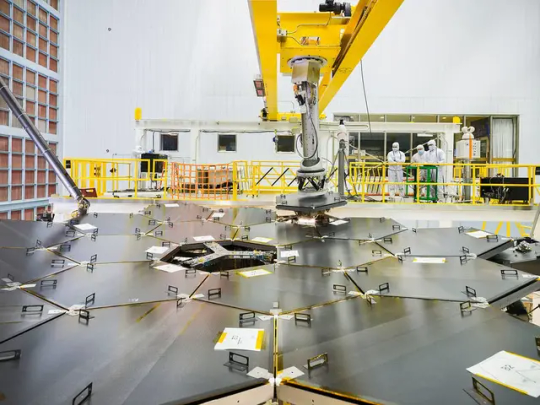

James Webb Space Telescope Mirror Seen in Full Bloom

Once the mirrors were completed, the science instruments were integrated into the telescope. While at Goddard, the telescope also underwent environmental testing – both acoustic and vibration – to ensure it would be able to withstand the rigors of launch. That successfully completed, the telescope was sent off to NASA Johnson in Houston, Texas, for tests of the optics and instruments at cryogenic temperatures. NASA Johnson’s Chamber A is the only thermal vacuum chamber NASA has that is large enough for Webb!
Once the telescope reached orbit, engineers on Earth made adjustments/corrections to the positioning of the Webb telescope’s primary mirror segments to bring them into alignment – to ensure they would produce sharp, focused images.
#science#nasa#goddard#james webb space telescope#james webb telescope#jwst#telescope#astronomy#physics#nasa johnson#johnson space center#houston texas#mirror polishing#Ball Aerospace#Marshall’s X-ray and Cryogenic Facility (XRCF)#xrcf#cryogenic#cryogenic testing#engineering#laser interferometer#goddard space flight center#jwst full bloom#science instruments#science achievement#human achievement
6 notes
·
View notes
Text
Scientists Discover Long Theorized 'Low Hum' Created by Supermassive Black Holes
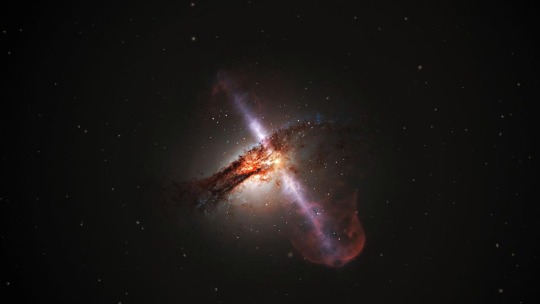
Scientific theories surrounding gravitational wave background signals may provide clues about the earliest days of the universe.
An international team of astronomers has discovered a faint hum that permeates the universe and will provide them clues about supermassive black holes, colliding galaxies and possibly the Big Bang.
The North American Nanohertz Observatory for Gravitational Waves (NANOGrav) published a study on Wednesday showcasing evidence of the long theorized but never proven gravitational wave background (GWB) noise, a type of signal they believe emanates from supermassive black holes and colliding galaxies and may contain traces of the gravitational ripples caused by the Big Bang.
Four of the study’s six papers were published in the Astrophysical Journal Letters, the remaining two have been accepted for publication at a later date. The discovery was first made in 2021, but the culmination of their work is just now being published.

‘Humming Universe’: Hint of Gravitational Wave ‘Background’ Detected As Study Probes Cosmic Mystery! visual of gravitational waves from two converging black holes is depicted on a monitor behind Laser Interferometer Gravitational-Wave Observatory (LIGO) Co-Founder Kip Thorne as he speaks to members of the media following a news conference at the National Press Club in Washington, Thursday, Feb. 11, 2016. © AP Photo/Andrew Harnik
While GWB had been theorized before, no direct evidence had been found until now.
Gravitational waves themselves are also technically a recent discovery. While they were first described in Einstein’s 1915 Theory of General Relativity, they had not been detected until 2015.
While every piece of matter in the universe emits gravitational waves - most of them are undetectable - scientists can only hope to observe the effects of some of the largest bodies in the universe.
That finally happened when the Laser Interferometer Gravitational-wave Observatory (LIGO) detected them for the first time in 2015. The LIGO shoots lasers down three-mile-long perpendicular tubes, with the hope that a gravitational wave will pass over it, causing one laser to shrink slightly while the other grows.
Started in 1994 and first completed in 1997, the LIGO cost $395 million to build and didn’t detect any waves for the first 10 years of its existence. It shut down temporarily for a $200 million upgrade and renovation before finally detecting a gravitational wave that scientists believe came from two black holes, roughly 30 times the size of the sun each, colliding about 1.3 billion light-years from Earth.
But LIGO is not capable of detecting GWB created by super massive black holes, which range from 100,000 to six billion times the size of the sun.
So instead, the scientists at NANOGrav looked to the stars, or more specifically pulsars.
Pulsars are dead stars, also known as neutron stars, that are highly magnetic and rotate roughly 700 times a second. Their spin is incredibly consistent and looks like flickering when observed from Earth. They are sometimes compared to lighthouses or clocks because of their consistency.
The NANOGrav astronomers watched pulsars for 15 years across different observatories in West Virginia, Puerto Rico, New Mexico and Canada, waiting for tiny variations that would indicate a gravitational wave from a supermassive black hole.
They were able to distinguish the signal from other gravitational waves because of the pattern it passed through the pulsar. GWBs are unique from other gravitational waves because they come so close together they overlap. The researchers describe it by comparing it to hearing a crowd of people talking at once. At first, it sounds like a low consistent hum, until you concentrate and can pick out specific conversations.
The same became true of GWBs once astronomers were able to detect the tiniest variations. Officials say they could predict the pulses from the pulsars down to 1 microsecond, the equivalent of measuring the distance of the moon within a thousandth of a millimeter.
“We are extraordinarily excited to see this pattern pop out finally,” said Stephen Taylor, a gravitational wave astrophysicist at Vanderbilt University, who co-led the research.
While scientists aren’t positive about the source of the GWB, it mirrored theories about the types of gravitational waves thought to be created by supermassive black holes.
Scientists also say the rate of the waves is increasing, suggesting there may be hundreds or even thousands of supermassive black holes that have not yet been discovered. The signals may help us discover where some of these objects are and how they work, as well as provide scientists clues into the formation of galaxies and even the universe.

Gravitational Waves May Be Generated From Debris Fields Around Dying Stars — Study June 7, 2023!
Scientists previously feared supermassive black holes would never collide and just continually orbit each other; this was called the “final parsec problem” in the astrophysicist community.
“To get these types of high amplitudes that we are seeing, we need fairly massive black holes, and they need to form binaries [aka supermassive black holes] quite frequently and evolve quite efficiently,” Luke Zoltan Kelley, an assistant professor at the University of California, Berkeley who participated in the NANOGrav study, said in a statement.
He adds if it is confirmed that the waves came from a supermassive black hole, “then they absolutely had to have passed the final parsec one way or another.”
— Ian DeMartino, Sputnik International, Wednesday June 28, 2023
#Laser Interferometer Gravitational-Wave Observatory (LIGO)#Gravitational Waves#Science & Tech.#Puerto Rico 🇵🇷#West Virginia#Earth#Albert Einstein
2 notes
·
View notes
Text
Laser light simultaneously shot down vacuum tunnels inside each tube, and reflected back by highly polished mirrors, is used to measure the relative length of each to fantastic accuracy.
"The Fabric of the Cosmos" - Brian Greene
#book quote#the fabric of the cosmos#brian greene#nonfiction#laser#light#vacuum#tunnels#laser interferometer gravitational wave observatory#ligo#fantastic#accuracy
0 notes
Text
CAN TWO SUPERMASSIVE BLACK HOLES MERGE??
Blog#440
Saturday, September 28th, 2024.
Welcome back,
A team of astrophysicists that includes the University of Toronto’s Gonzalo Alonso-Álvarez has shown that pairs of supermassive black holes can merge together into a single, larger black hole – a major breakthrough in addressing what is known as the "final parsec problem."
longstanding astrophysics problem refers to a discrepancy between the detection of gravitational signals permeating the universe – which astrophysicists previously hypothesized had emanated from millions of merging pairs of supermassive black holes (SMBHs) – and theoretical simulations which showed that the approach of SMBHs stalls when they’re roughly one parsec (about three light years) apart.

Not only did the final parsec problem conflict with the theory that merging SMBHs were the source of the gravitational wave background, it was also at odds with the theory that SMBHs – each billions of times more massive than our Sun – grow from the merger of less massive black holes.
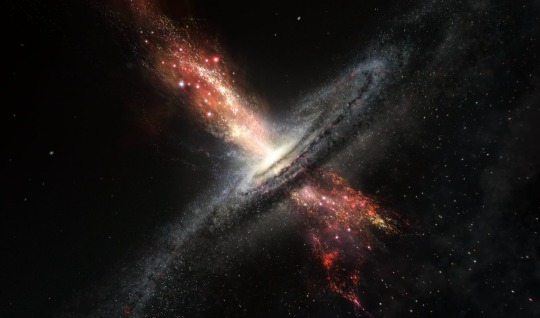
The new research, published in Physical Review Letters, has shown that pairs of SMBHs can indeed break through the one-parsec barrier and merge into a single black hole. This is demonstrated by calculations showing that SMBHs continue to draw closer because of previously overlooked interactions with particles within the vast cloud of dark matter surrounding them.

“We show that including the previously overlooked effect of dark matter can help supermassive black holes overcome this final parsec of separation and coalesce,” says Alonso-Álvarez, a post-doctoral fellow in the department of physics at U of T’s Faculty of Arts & Science and the department of physics and Trottier Space Institute at McGill University, who is first author on the paper. “Our calculations explain how that can occur, in contrast to what was previously thought.”

SMBHs are thought to lie in the centres of most galaxies. When two galaxies collide, the SMBHs fall into orbit around each other; as they revolve around each other, the gravitational pull of nearby stars tugs at them and slows them down, causing them to spiral inward toward a merger.
Previous merger models showed that when the SMBHs approached to within roughly a parsec, they begin to interact with the dark matter cloud or halo in which they are embedded. These models indicated that the gravity of spiraling SMBHs throws dark matter particles clear of the system.

The new model introduced by Alonso-Álvarez and co-authors James Cline, a professor at McGill University and the European Organization for Nuclear Research (CERN) in Switzerland, and Caitlyn Dewar, a graduate student at McGill, reveals that dark matter particles interact with each other in such a way that they are not dispersed. The density of the dark matter halo remains high enough that interactions between the particles and the SMBHs continue to degrade the SMBH’s orbits – clearing a path to a merger.

“The possibility that dark matter particles interact with each other is an assumption that we made, an extra ingredient that not all dark matter models contain,” says Alonso-Álvarez. “Our argument is that only models with that ingredient can solve the final parsec problem.”
The background hum generated by these colossal cosmic collisions is made up of gravitational waves of much longer wavelength than those first detected in 2015 by astrophysicists operating the Laser Interferometer Gravitational-Wave Observatory (LIGO).

Those gravitational waves were generated by the merger of two black holes, both some 30 times the mass of the Sun.
The background hum has been detected in recent years by scientists operating the Pulsar Timing Array. The array reveals gravitational waves by measuring minute variations in signals from pulsars, rapidly rotating neutron stars that emit strong radio pulses.
Originally published on https://www.utoronto.ca
COMING UP!!
(Wednesday, October 2nd, 2024)
"WHERE DID MARS' ATMOSPHERE GO??"
#astronomy#outer space#alternate universe#astrophysics#universe#spacecraft#white universe#space#parallel universe#astrophotography
76 notes
·
View notes
Text
Queer Figures in Astronomy & Space Exploration: Dr. Nergis Mavalvala

Dr. Nergis Mavalvala is a Pakistani-American astrophysicist known for her work with gravitational waves
Born in Lahore, Pakistan in 1968, and holds dual Pakistani and American citizenship
Professor of Astrophysics and Dean of Science at the Massachusetts Institute of Technology
First woman to serve as MIT’s Dean of Science
Her 1997 PhD thesis dealt with her work with German-American physicist Rainer Weiss on designing a laser interferometer to detect ripples in spacetime known as gravitational waves
Ideas from Mavalvala’s thesis contributed to the eventual design of the Laser Interferometer Gravitational-Wave Observatory (LIGO)
She was a member of the team that first detected gravitational waves on 14 September, 2015, roughly 100 years after Albert Einstein had predicted their existence
The discovery was announced on 11 February, 2016, and is known as the GW150914 Event
Mavalvala is openly a lesbian, and she and her partner have 2 children
#solreefspeak#space things#queer#lgbtq#lesbian#queer figures in astronomy & space exploration#pride month#nergis mavalvala#part 1 of my project for this month! hoping to post every other day :)
9 notes
·
View notes
Text


Personally, I think Professor Calculus would just really enjoy lasers…
He spent all night aligning this interferometer, and when he didn’t show up for breakfast, Tintin and Haddock went to see what he was up to, and Haddock took him a cup of tea.
“Look, it’s finally working! Now I just need to screw all the components down to the table…”
This as a cautionary tale: always screw down optical components!!
Snowy wants to know why the Professor is so sad.
14 notes
·
View notes
Text

Study reveals new source of the heavy elements
Stellar collapse and explosions distribute gold throughout the universe
Magnetar flares, colossal cosmic explosions, may be directly responsible for the creation and distribution of heavy elements across the universe, suggests a new study.
For decades, astronomers only had theories about where some of the heaviest elements in nature, like gold, uranium and platinum, come from. But by taking a fresh look at old archival data, researchers now estimate that up to 10% of these heavy elements in the Milky Way are derived from the ejections of highly magnetized neutron stars, called magnetars.
Until recently, astronomers had unwittingly overlooked the role that magnetars, essentially dead remnants of supernovae, might play in early galaxy formation, said Todd Thompson, co-author of the study and a professor of astronomy at The Ohio State University.
“Neutron stars are very exotic, very dense objects that are famous for having really big, very strong magnetic fields,” said Thompson. “They’re close to being black holes, but are not.”
While the origins of heavy elements had long been a quiet mystery, scientists knew that they could only form in special conditions through a method called the r-process (or rapid-neutron capture process), a set of unique and complex nuclear reactions, said Thompson.
Scientists saw this process in action when they detected the collision of two super-dense neutron stars in 2017. This event, captured using NASA telescopes, the Laser Interferometer Gravitational wave Observatory (LIGO) and other instruments, provided the first direct evidence that heavy metals were being created by celestial forces.
But further evidence showed that other mechanisms might be needed to account for all these elements, as neutron star collisions might not produce heavy elements fast enough in the early universe. According to this new study, building on these clues helped Thompson and his collaborators recognize that powerful magnetar flares could indeed serve as a potential ejectors of heavy elements, a finding confirmed by 20-year-old observations of SGR 1806–20, a magnetar flare so bright that some measurements of the event could only be made by studying its reflection off the moon.
By analyzing this magnetar flare event, researchers determined that the radioactive decay of the newly created elements matched up with their theoretical predictions about the timing and types of energies released by a magnetar flare after it ejected heavy r-process elements. The researchers also theorized that magnetar flares produce heavy cosmic rays, extremely high-velocity particles whose physical origin remains unknown.
“I love new ideas about how systems work, how new discoveries work, how the universe works,” Thompson said. “That’s why results like this are really exciting.”
The study was recently published in The Astrophysical Journal Letters.
Magnetars may provide unique insights into galactic chemical evolution, including the formation of exoplanetary systems and their habitability.
Not only do magnetars produce valuable metals like gold and silver that end up on Earth, the supernova explosions that cause them also produce elements like oxygen, carbon and iron that are vital for many other, more complex celestial processes.
“All of that material they eject gets mixed into the next generation of planets and stars,” said Thompson. “Billions of years later, those atoms are incorporated into what could potentially amount to life.”
Altogether, these findings have deep implications for astrophysics, particularly for scientists studying the origin of both heavy elements and fast radio bursts – brief shivers of electromagnetic radio waves from faraway galaxies. Understanding how matter ejects from magnetars could help scientists learn more about them.
Due to their rarity and short duration, magnetar flares can be difficult to observe,
and current space-based telescopes like the James Webb Space Telescope and Hubble don’t have the dedicated abilities needed to detect and study their emission signals. Even more specialized observatories like NASA’s Fermi Gamma-ray Space Telescope can only see the brightest part of gamma-ray flashes from nearby galaxies.
Instead, one proposed NASA mission, the Compton Spectrometer and Imager (COSI), could bolster the team’s work by surveying the Milky Way for energetic events like giant magnetar flares. Though another event like SGR 1806-20 might not occur this century, if a magnetar flare did detonate in our backyard, COSI could be used to better identify the individual elements created from its eruption and allow this team of researchers to confirm their theory about where heavy elements in the universe come from.
“We’re generating a bunch of new ideas about this field, and ongoing observations will lead to even more great connections,” said Thompson.
IMAGE: Magnetars have magnetic fields that are a trillion times more powerful than those of ordinary stars. Photo: Getty Images
5 notes
·
View notes
Text
Atomic space and gravitational waves. On September 14, 2015, the Laser Interferometer Gravitational-Wave Observatory (LIGO) became the first observatory to detect gravitational waves on Earth. When two black holes, located about 1.3 billion light-years from Earth, merged, they created gravitational waves - ripples in space and time. The detected signal came from the merger of two giant black holes - with masses of 36 and 29 solar masses. Gravitational waves from their collision reached the LIGO detector, causing the distance between its mirrors, separated by 4 kilometers, to change by about 1/1000th the diameter of a proton. In the video, the proton's motion shows tiny changes measured by LIGO detectors. Video: LIGO Lab Caltech/MIT
23 notes
·
View notes
Text
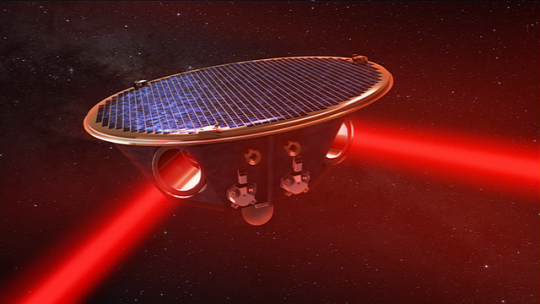
The LISA
The Lisa (Laser Interferometer Space Antenna) mission, led by ESA (European Space Agency) with NASA contributions, will detect gravitational waves in space using three spacecraft, separated by more than a million miles, flying in a triangular formation.
Lasers fired between the satellites, shown in this artist's concept, will measure how gravitational waves alter their relative distances.
AEI/MM/Exozet
#art#cosmos#cosmic#universe#blast#space#lisa#laser#esa#nasa#science#spacecraft#artist concept#AEI#MM#exozet#space exploration
34 notes
·
View notes
Text

A new simple scheme for atom interferometry
Atom interferometers are devices that use the wave characteristics of matter to measure the phase between atomic matter waves to separate paths to make high-precision measurements of elements of physics, such as gravitational and magnetic fields. Atom interferometers have also found their way into industry and are used in geological surveys, mineral exploration, environmental monitoring, and for the development of precision atomic clocks. Atom interferometers usually control matter waves and particularly particle velocity using lasers. Thus, the growth of atom interferometer application has been strongly tied to the development of advanced laser systems, with many current models based on the construction of gratings fashioned from laser beams.
Read more.
12 notes
·
View notes
Text

youtube
🎬 Watch The Television Show Trailer in the comments below:
Tuesday, Aug 27, 2024. Episode #1418 of 🎨#JamieRoxx’s www.PopRoxxRadio.com 🎙️#TalkShow and 🎧#Podcast w/ Featured Guest:
#ErinMacdonald (#PhD, #Astrophysics) is a #writer, #speaker, #producer, and #scienceadvisor, best known for her current work as the official science advisor for the #STARTREK franchise. Also Voice Actor on #StarTrekProdigy and the video game #StarTrekOnline.
Pop Art Painter Jamie #Roxx (www.JamieRoxx.us) welcomes Erin Macdonald (PhD, Astrophysics) is a writer, speaker, producer, and science advisor, voice Actress to the Show!
(Click to go there) ● WEB: www.erinpmacdonald.com ● IG: @drerinmac ( www.instagram.com/drerinmac ) ● IMDB: www.imdb.com/name/nm8574394
Erin Macdonald (PhD, Astrophysics) is a writer, speaker, producer, and science advisor, best known for her current work as the official science advisor for the STAR TREK franchise. She has also voiced her fictional counterpart in the Star Trek universe: Lt Cmdr Dr Erin Macdonald in Star Trek: Prodigy and the video game Star Trek Online. Known as “The Julia Child of Science,” as a science communicator Erin has appeared on NPR's Science Friday and Short Wave podcasts, provided commentary for numerous docuseries, and wrote and hosted the award-winning "Science of Star Trek" promotional videos for Paramount+. She wrote the baby board book "Star Trek: My First Book of Space" and wrote and narrated the Audible Original "The Science of Sci-Fi" in collaboration with The Great Courses.Prior to all of this work, she received her PhD at 25 at the University of Glasgow in Scotland and conducted research with the Laser Interferometer Gravitational-wave Observatory (LIGO) Scientific Collaboration, but left shortly before their 2017 Nobel Prize-winning discovery of gravitational waves. She also has worked as a museum educator, community college professor, and Department of Defense systems engineering technical advisor. She received dual BA’s from the University of Colorado at Boulder in Physics with Astrophysics (cum laude ) and Mathematics. Through her company Spacetime Productions, she produces award-winning sci-fi films by LGBTQIA+ creators. Her most recent film IDENTITEAZE written and directed by Jessie Earl is available for streaming at go.nebula.tv/identiteaze.
● Media Inquiries: Annie Jeeves Publicist Cinematic Red PR cinematicred.com
7 notes
·
View notes
Text
Capturing The Ripples of Spacetime: LISA Gets Go-ahead
— January 25th, 2024
Today, ESA’s Science Programme Committee approved the Laser Interferometer Space Antenna (LISA) mission, the first scientific endeavour to detect and study gravitational waves from space.
This important step, formally called ‘adoption’, recognises that the mission concept and technology are sufficiently advanced, and gives the go-ahead to build the instruments and spacecraft. This work will start in January 2025 once a European industrial contractor has been chosen.
LISA is not just one spacecraft but a constellation of three. They will trail Earth in its orbit around the Sun, forming an exquisitely accurate equilateral triangle in space. Each side of the triangle will be 2.5 million km long (more than six times the Earth-Moon distance), and the spacecraft will exchange laser beams over this distance. The launch of the three spacecraft is planned for 2035, on an Ariane 6 rocket.
Led by ESA, LISA is made possible by a collaboration between ESA, its Member State space agencies, NASA, and an international consortium of scientists (the LISA consortium).
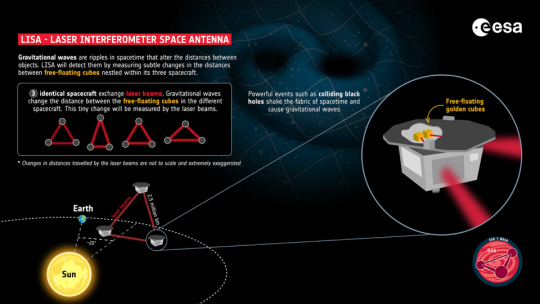
LISA – Measuring Gravitational Waves
Bringing ‘Sound’ To The Cosmic Movie
Just over a century ago, Einstein made the revolutionary prediction that when massive objects accelerate, they shake the fabric of spacetime, producing miniscule ripples known as gravitational waves. Thanks to modern technological developments, we are now able to detect these most elusive of signals.
“LISA is an endeavour that has never been tried before. Using laser beams over distances of several kilometres, ground-based instrumentation can detect gravitational waves coming from events involving star-sized objects – such as supernova explosions or merging of hyper-dense stars and stellar-mass black holes. To expand the frontier of gravitational studies we must go to space,” explains LISA lead project scientist Nora Lützgendorf.
“Thanks to the huge distance travelled by the laser signals on LISA, and the superb stability of its instrumentation, we will probe gravitational waves of lower frequencies than is possible on Earth, uncovering events of a different scale, all the way back to the dawn of time.”

The Spectrum of Gravitational Waves
LISA will detect, across the entire Universe, the ripples in spacetime caused when huge black holes at the centres of galaxies collide. This will enable scientists to trace the origin of these monstrous objects, to chart how they grow to be millions of times more massive than the Sun and to establish the role they play in the evolution of galaxies.
The mission is poised to capture the predicted gravitational ‘ringing’ from the initial moments of our Universe and offer a direct glimpse into the very first seconds after the Big Bang. Additionally, because gravitational waves carry information on the distance of the objects that emitted them, LISA will help researchers measure the change in the expansion of the Universe with a different type of yardstick from the techniques used by Euclid and other surveys, validating their results.
Closer to home, in our own galaxy, LISA will detect many merging pairs of compact objects like white dwarfs or neutron stars and give us a unique insight into the final stages of the evolution of these systems. By pinpointing their position and distances, LISA will further our grasp of the structure of the Milky Way, building upon the findings from ESA's Gaia mission.
“For centuries we have been studying our cosmos through capturing light. Coupling this with the detection of gravitational waves is bringing a totally new dimension to our perception of the Universe,” remarks LISA project scientist Oliver Jennrich.
“If we imagine that, so far, with our astrophysics missions, we have been watching the cosmos like a silent movie, capturing the ripples of spacetime with LISA will be a real game-changer, like when sound was added to motion pictures.”

Golden Cubes For LISA
Golden Cubes and Laser Beams
To detect gravitational waves, LISA will use pairs of solid gold-platinum cubes – so called test masses (slightly smaller than Rubik’s cubes), free-floating in special housing at the heart of each spacecraft. Gravitational waves will cause tiny changes in the distances between the masses in the different spacecraft, and the mission will track these variations using laser interferometry.
This technique requires shooting laser beams from one spacecraft to the other and then superimposing their signal to determine changes in the masses’ distances down to a few billionths of a millimetre.
The spacecraft must be designed to ensure that nothing, besides the geometry of spacetime itself, affects the movement of the masses, which are in freefall.
Solid Heritage and Future Teamwork
The spacecraft follows in the footsteps of LISA Pathfinder, which demonstrated that it is possible to keep the test masses in freefall to an astonishing level of precision. The same precision propulsion system that has also been flown on ESA’s Gaia and Euclid missions will ensure that each spacecraft maintains the required position and orientation with the highest accuracy.
Selected to be the third large mission of ESA’s Cosmic Vision 2015–2025, LISA will join ESA’s science fleet of cosmic observers to address two essential questions at the heart of the programme: What are the fundamental physical laws of the Universe? How did the Universe originate and what is it made of?
In this quest, LISA will work together with ESA’s other large mission currently under study: NewAthena. With a launch date foreseen for 2037, NewAthena is set to be the largest X-ray observatory ever built.
Notes For Editors:
ESA leads the LISA mission and will provide the spacecraft, launch, mission operations and data handling. Key instrumental elements are the free-falling test masses shielded from external forces, provided by Italy and Switzerland; the picometre-accuracy systems to detect the interferometric signal, provided by Germany, the UK, France, the Netherlands, Belgium, Poland and the Czech Republic; and the Science Diagnostics Subsystem (an arsenal of sensors across the spacecraft), provided by Spain. The ultra-stable lasers, the 30 cm telescopes to collect their light, and the sources of UV light (to discharge the test masses) will be provided by NASA.
#ESA | Science & Exploration | Space Science#Laser Interferometer Space Antenna (LISA)#NASA#European Space Agency (ESA)#Science & Exploration
1 note
·
View note
Text
With LIGO and its subsequent improvements,* we will view the cosmos in a completely new way.
* One of these is the planned Laser Interferometer Space Antenna (LISA), a space-based version of LIGO comprising multiple spacecraft, separated by millions of kilometers, playing the role of LIGO's four-kilometer tubes. There are also other detectors that are playing a critical role in the search for gravitational waves, including the German-British detector GEO600, the French-Italian detector VIRGO, and the Japanese detector TAMA300.
"The Fabric of the Cosmos" - Brian Greene
#book quotes#the fabric of the cosmos#brian greene#nonfiction#laser interferometer gravitational wave observatory#ligo#improvements#cosmos#laser interferometer space antenna#lisa#germany#britain#geo600#france#italy#virgo#japan#tama300#spacecraft#tubes#gravitational waves#detection
1 note
·
View note
Text
NASA Reveals Prototype Telescope for Gravitational Wave Observatory
NASA has revealed the first look at a full-scale prototype for six telescopes that will enable, in the next decade, the space-based detection of gravitational waves — ripples in space-time caused by merging black holes and other cosmic sources. The LISA (Laser Interferometer Space Antenna) mission is led by ESA (European Space Agency) in partnership […] from NASA https://ift.tt/BeUP295
5 notes
·
View notes
Text
IS TIME INFINITE IN BLACK HOLES??
Blog#365
Wednesday, January 10th, 2024.
Welcome back,
The singularity at the center of a black hole is the ultimate no man's land: a place where matter is compressed down to an infinitely tiny point, and all conceptions of time and space completely break down. And it doesn't really exist. Something has to replace the singularity, but we're not exactly sure what.
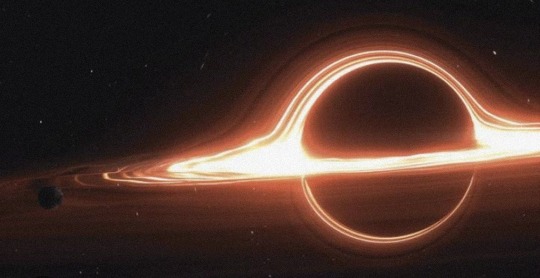
Let's explore some possibilities.
It could be that deep inside a black hole, matter doesn't get squished down to an infinitely tiny point. Instead, there could be a smallest possible configuration of matter, the tiniest possible pocket of volume.
This is called a Planck star, and it's a theoretical possibility envisioned by loop quantum gravity, which is itself a highly hypothetical proposal for creating a quantum version of gravity.

In the world of loop quantum gravity, space and time are quantized — the universe around us is composed of tiny discrete chunks, but at such an incredibly tiny scale that our movements appear smooth and continuous.
This theoretical chunkiness of space-time provides two benefits. One, it takes the dream of quantum mechanics to its ultimate conclusion, explaining gravity in a natural way.
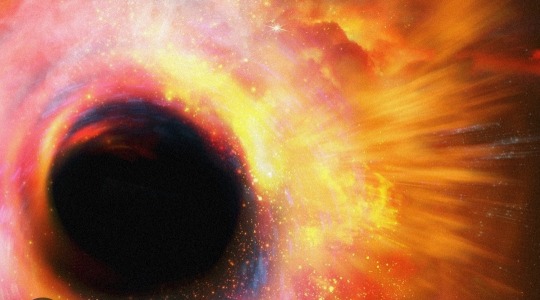
And two, it makes it impossible for singularities to form inside black holes.
As matter squishes down under the immense gravitational weight of a collapsing star, it meets resistance. The discreteness of space-time prevents matter from reaching anything smaller than the Planck length (around 1.68 times 10^-35 meters). All the material that has ever fallen into the black hole gets compressed into a ball not much bigger than this.

Perfectly microscopic, but definitely not infinitely tiny.
This resistance to continued compression eventually forces the material to un-collapse (i.e., explode), making black holes only temporary objects. But because of the extreme time dilation effects around black holes, from our perspective in the outside universe it takes billions, even trillions, of years before they go boom. So we're all set for now.
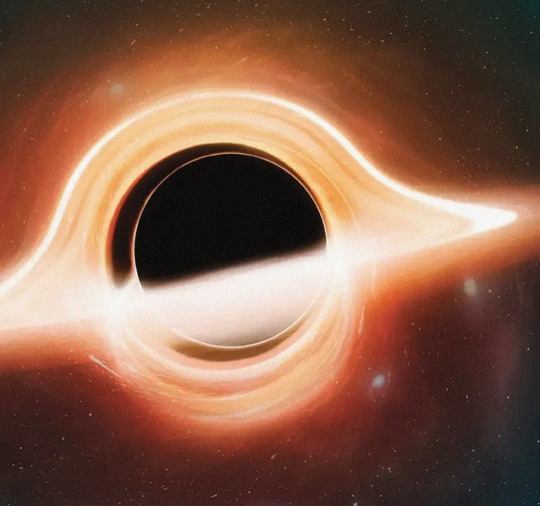
Another attempt to eradicate the singularity — one that doesn't rely on untested theories of quantum gravity — is known as the gravastar. It's such a theoretical concept that my spell checker didn't even recognize the word.
The difference between a black hole and a gravastar is that, instead of a singularity, the gravastar is filled with dark energy. Dark energy is a substance that permeates space-time, causing it to expand outward. It sounds like sci-fi, but it's real: dark energy is currently in operation in the larger cosmos, causing our entire universe to accelerate in its expansion.

As matter falls onto a gravastar, it isn't able to actually penetrate the event horizon (due to all that dark energy on the inside) and therefore just hangs out on the surface. But outside that surface, gravastars look and act like normal black holes. (A black hole's event horizon is its point of no return — the boundary beyond which nothing, not even light, can escape.)
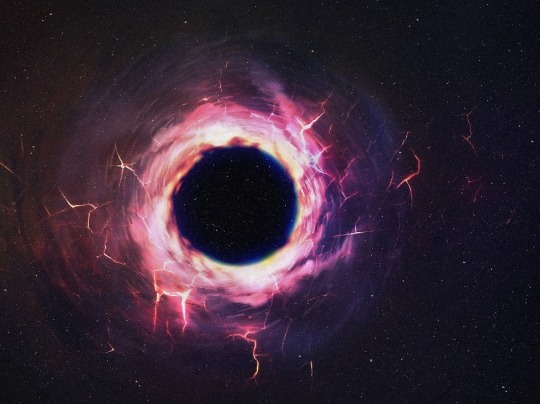
However, recent observations of merging black holes with gravitational wave detectors have potentially ruled out the existence of gravastars, because merging gravastars will give a different signal than merging black holes, and outfits like LIGO (the Laser Interferometer Gravitational-Wave Observatory) and Virgo are getting more and more examples by the day. While gravastars aren't exactly a no-go in our universe, they are definitely on thin ice.
Originally published https://www.space.com/
COMING UP!!
(Saturday, January 13th, 2024)
"JUPITER HAS A LARGE MAGNETIC FIELD THAN PREVIOUSLY EXPECTED??"
#astronomy#outer space#alternate universe#astrophysics#universe#spacecraft#white universe#parallel universe#astrophotography#space#blackholes#black holes
154 notes
·
View notes
Text
Read in 2025
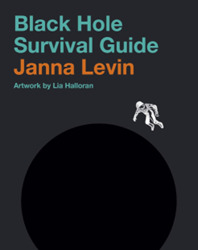
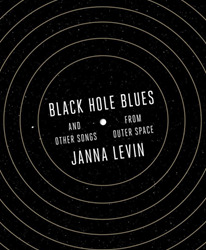
Janna Levin, Black Hole Survival Guide
Janna Levin, Black Hole Blues
I read Black Hole Survival Guide a few weeks ago and frankly can’t remember much about it. What I do recall is Janna Levin, much as in her other book I've read, How the Universe Got Its Spots, does a fairly good job of telling you about a weird part of astrophysics, in this case the strange world of black holes, but not in a way that stands out as strikingly different from what you probably know already – that they suck everything and don’t let much out (some Hawking radiation, whatever that is, I think).
Black Hole Blues, on the other hand, I thought was a remarkable book. It's about how the Laser Interferometer Gravitational-Wave Observatory, better known as LIGO, came into being. That’s the story of three physicists – each crazy in their own way – and various other players who between them were able to negotiate the tricky task of extracting hundreds of millions of dollars from the US’s National Science Foundation and use that money to build a pair of installations each with two 4-kilometre-long empty tubes that thanks to lasers and mirrors would be able to detect gravitational waves arising from two black holes collapsing into each other.
In other words, she tells you how science gets done, with a flavour of the kind of people who do it and many other bits and pieces, including a hint of the politics involved (why on earth otherwise would one of those installations be built in Louisiana?). Having lifted the cover on this very murky world, we better hope that not too many people pay attention, especially nowadays given who might want to have a say in how such government money is spent.
3 notes
·
View notes